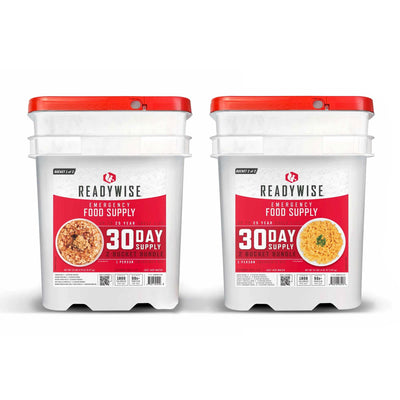Sheltering in Place: What to Do
Sometimes, the smartest thing a person can do during or immediately after an emergency is to just stay put. Sheltering in place is typically advised by local officials when evacuating (or travel in general) is considered to be less safe than hunkering down and staying at home.

But what does ‘sheltering in place’ mean, exactly? And what steps should you be taking to protect you and your family in an emergency? Find out more below.
What Is Sheltering in Place?
Sheltering in place is a protective action that involves seeking shelter in a safe location, such as a building or even in your vehicle in some circumstances. Oftentimes, sheltering in place advisories are issued when the option for evacuation is considered unnecessary or the time for evacuating has already passed.
Sheltering in place advisories are commonly issued for hurricanes, severe winter storms and other natural disasters. However, there are other potential reasons why sheltering in place orders are given: poor air quality, airborne illness, chemical hazards and active shooter situations, to name just a few.
How to Shelter in Place
Sheltering in place strategies may vary based on the type of emergency. For instance, how you might hunker down for a Cat 3 hurricane may look slightly different than, say, how you shelter in place during a pandemic.
However, one thing that remains constant is the need for emergency preparedness. With solid planning, preparation and practice, you and your family can potentially reduce the impact of an emergency while sheltering in place.
How to Prepare:
- Stay Informed – Whether it’s a hurricane, wildfire or an active shooter, dangerous situations can develop quickly and often change course just as fast. To stay in the know, sign up to receive your local community’s warning system. If you live in a natural disaster-prone area, consider picking up a special weather radio to receive emergency information from the NOAA Weather Radio All Hazards, or NWR. You can usually find NWR radios at big box stores or department stores.
- Make a Plan – Get together with your family and come up with a sheltering in place plan for different types of emergencies and scenarios. For instance, which room in your home will you shelter in during a tornado? If you’re not sheltering in place together, how will you communicate with each other? Make sure everyone is involved in the planning stage and knows exactly what their individual responsibilities are.

- Stockpile Food and Water – Don’t wait until the last minute to start building your emergency food and water supply. If you do, the store shelves will be wiped clean due to people panic-buying everything. Be prepared by stocking up on non-perishable foods and bottled water now. Your supply should last you a minimum of two weeks.
- Keep a Hard Cooler Available – In the case of a power outage, be prepared to transfer the contents of your refrigerator to a couple of hard coolers. This can help buy you more time if the power is out for longer than a few hours. To maximize the longevity of your food, learn how to use dry ice in a cooler. At -109°F, dry ice will help keep your food cold for at least a couple of days. Note: Be sure to buy dry ice before a sheltering in place order goes into effect.
- Build an Emergency Kit – Have an emergency kit that’s tailored specifically for a shelter in place order. For instance, you could stock it with a N95 mask to filter out contaminated air. Plastic sheeting, towels, scissors and duct tape are useful in case you need to seal yourself from the outside. If the safest room in your home doesn’t have a toilet, a plastic toilet bucket stocked with toilet paper and moist towelettes will be useful. And don’t forget to consider other essentials such as first aid supplies, a flashlight, extra batteries, a radio, blankets, and at least three days’ worth of food and water for your entire family (including your pets).

64 Piece Survival Kit Backpack
- Prepare Your Vehicle – In some emergencies, the safest option may be to stay put in your vehicle. Keep an emergency kit stocked with food, water and other emergency items in your car. Don’t forget to test out the items in advance! A car window breaker won’t do you any good in an emergency unless you know how to use it.
What to Do:
- Act Quickly – If local officials tell you to take shelter, listen to them and act swiftly. Round up your family members and bring everyone inside. If you’re away from home and officials tell you to find the nearest shelter, don’t try to stop by the grocery store for emergency supplies. Find the safest building near you and stay put. If you’re in your vehicle, find a safe location to pull over, turn off the engine and wait until authorities tell you it’s safe to drive again.
- Seal Your Home – If you have time, lock your doors and windows. Whether you’re sheltering in place for a chemical hazard, an active shooter or a severe storm, shutting and locking your home can help increase your safety. If contaminated air is a concern, turn off things that circulate air in your home, such as fans and air conditioners.
- Don’t Leave Your Shelter – Unless you’ve been instructed to do so, don’t leave your shelter. It might sound obvious to you now, but it’s easy to panic during an emergency and accidentally put yourself in harm’s way. If the kids are at school, DON’T pick them up unless officials instruct you to do so. Their school should have a shelter in place plan designed to protect them.
- Monitor the Situation – Watch the news, listen to the radio or check your phone for news updates regularly. Hurricanes, tornados and other emergency situations can go from bad to worse quickly. Stay on top of developing news stories and re-evaluate your shelter in place plan as needed.

Stay Safe by Staying in Place
When the time for evacuation has passed, sheltering in place may be the safest option. However, keep in mind that the best practices for sheltering in place can vary depending on the type of emergency, the specific situation and by city. You may find yourself sheltering for a few hours in a tiny room or spend weeks limiting travel outside your home. By preparing for a wide range of possible situations, you can maximize your safety while sheltering in place.
Images:
https://www.shutterstock.com/image-photo/family-house-529030726
https://www.shutterstock.com/image-illustration/home-safety-house-under-glass-bell-563225215

















































































